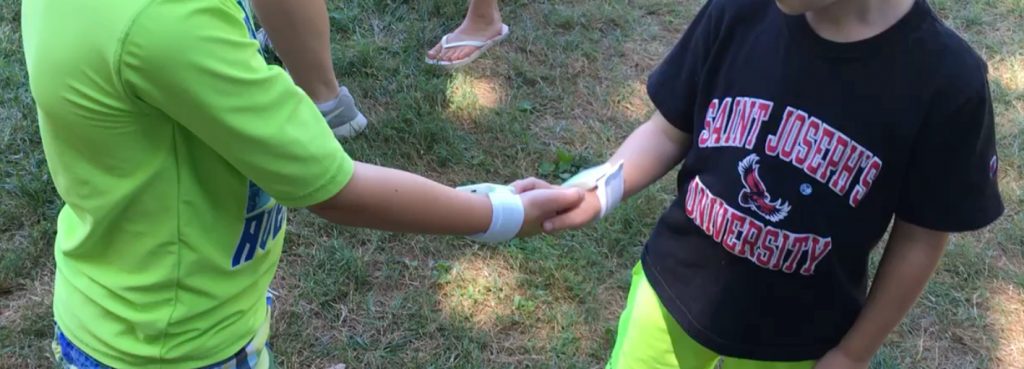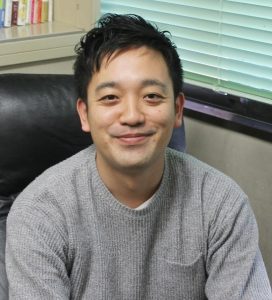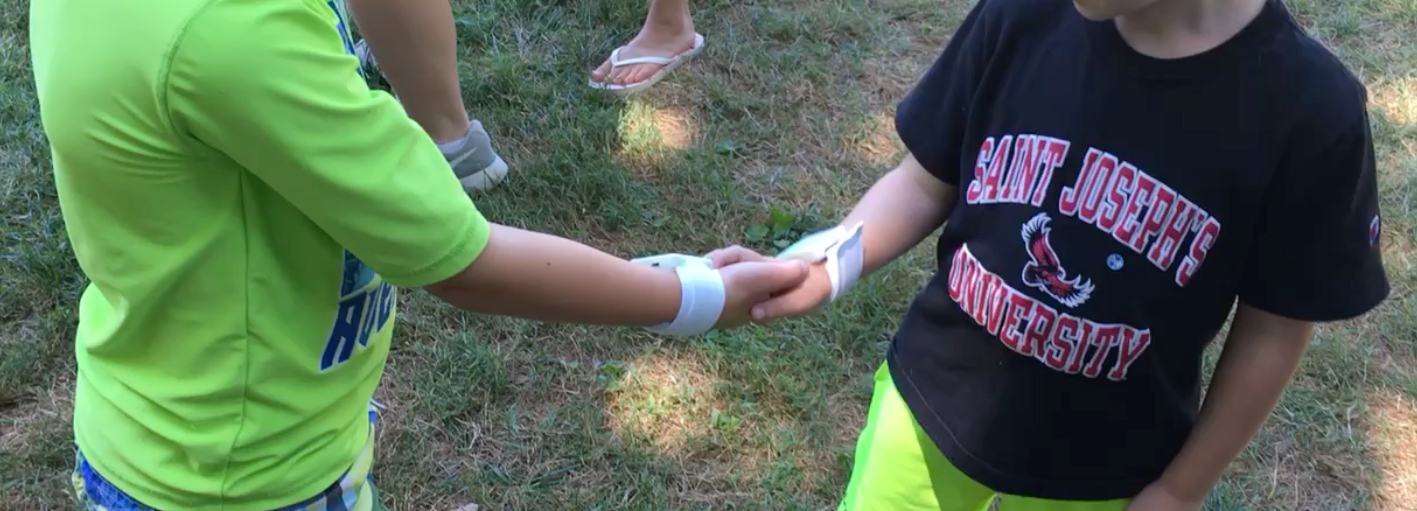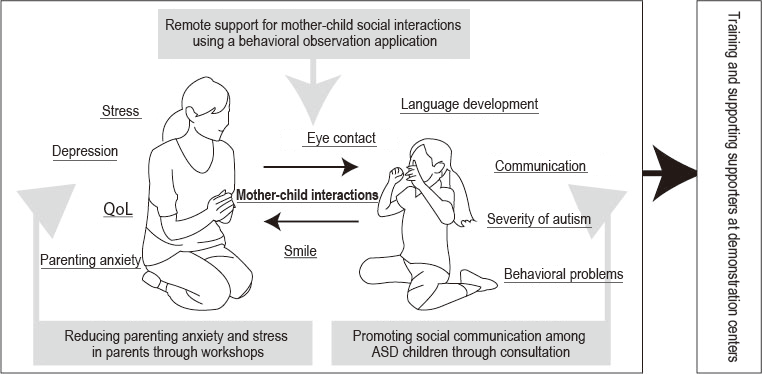他のメンバー : 岡崎 慎治 柘植 雅義 佐々木 銀河 井澤 淳 北原 格 澤江 幸則 羽田 康司 石塚 祐香 石川 公久
他機関 : 山本 淳一 作田 亮一 井上 雅彦
ASD(自閉スペクトラム症)のある人々に対し、社会的に適切な行動ができるよう支援するための応用行動分析が有効であることが明らかになっています。障害科学の分野で様々な分析や支援の研究が進む一方で、ICTやAIなどの技術の発展によって社会はより速いスピードで目まぐるしく変化しています。
学際的自閉症研究・リサーチユニットは、障害科学、心理学、工学、医学、スポーツ科学分野の研究者が集結し、最新のテクノロジーを活用したASD児の行動分析・支援研究を行う国内外において極めて稀な研究チームです。
ICT技術を活用し自閉症児の応用行動分析から新たな支援方法を開発する
多くの自閉症児は対人接触が苦手でコミュニケーションの障害になっています。

図1:Enhanced Touchを使用している様子
そこで、当ユニットでは人と人の接触を促すデバイス「Enhanced Touch」を開発し検証を行いました。Enhanced Touchはブレスレット型で触れると光り、どちらから触れたのか、触れていた時間を計測し記録する機能があります。
このデバイスを使用することにより、ASD児と非ASD児を問わず身体接触や、それに伴った言語・非言語コミュニケーションが増加し、取得したデータでより詳細な分析が可能となるほか、デバイスを外した後でもコミュニケーション量を維持することが期待されています。今後はアメリカのサマーキャンプなどにEnhanced Touchを導入することも検討しています。
そのほかのユニットの研究活動として、ASD児に特有の視線の動きと学習機能の関係を分析するために、アイトラッカーや多視点映像を利用した支援システムの開発も行っています。障がい者支援にセンシング技術を応用することは、障害科学分野だけではなし得なかった発想です。心理学・工学・医学・スポーツ科学の多分野融合チームの連携で、学際的自閉症研究に端を発した新しい支援の輪が広がりつつあります。
遠隔支援システムによって子育ての不安を減らす

図2:遠隔支援システム利用時の母子間相互作用
ASD児・保護者遠隔支援システムの開発も、当ユニットの研究における大きな柱のひとつです。「ペアレントトレーニング」は保護者が専門家からASD児への関わり方についてフィードバックを受けることができる仕組みです。病院においては非常に有効ですが自宅での両親とASD児の関わりにはフィードバックを受けることができない課題がありました。そこで、本リサーチユニットは、両親が自宅での様子をビデオ撮影し、専門家と共有するアプリケーションを使って、自宅でのASD児との関わり方に医師や専門家のアドバイスを受けられるシステムを構築しました。このような方法でASD児を持つ親の不安を減らすなど、育児支援を行っています。
将来的には日本中のASDに関わる様々なデータを集積する「自閉症児研究センター」を設立し、心理や障害、工学分野間の橋渡し機能を担うことも視野に入れてネットワークを広げています。眼鏡というテクノロジーのおかげで目の悪さが「障害」とされないことと同様に、支援機器の普及により最終的にはASDが障害とされない社会実現のため研究の実用化を目指します。
社会への貢献・実績
-
工学デバイスを用いた応用行動分析
-
行動観察アプリケーションを活用した、心理学・医学・情報学の連携によるASD児・保護者遠隔支援システムの開発
取材日:2020年2月6日
Disseminating Communication Support Devices and Systems to Realize a Society Where ASD Is Not Regarded as a Disability
Unit members : OKAZAKI, Shinji Tsuge, Masayoshi Sasaki, Ginga Izawa, Jun Kitahara, Itaru Sawae, Yukinori Hada, Yasushi Ishizuka, Yuka Ishikawa Kimihisa
Other agencies : Yamamoto Jun-ichi Sakuta Ryoichi Inoue masahiko
Unit name: Research Unit for Interdisciplinary Autism Research
Keywords: Autism spectrum disorder developmental support Wearable device

Interview with Dr. Matsuda Soichiro
Applied Behavior Analysis has been shown to be effective to help people with autism spectrum disorder (ASD) adopt socially correct behaviors. While various analyses and studies on support are proceeding in the field of disability science, the development of technologies represented by ICT and AI is making our society markedly change at an accelerated pace.
The Research Unit for Interdisciplinary Autism Research, where researchers specializing in disability science, psychology, engineering, medicine, and sports science work together on behavioral analysis and studies to support children with ASD using the latest technologies, is a rare research team for both Japan and other countries.
Utilizing ICT technology and the results of applied behavior analysis to develop new methods of support for children with autism
Many children with autism have communication difficulties, because they are not good at physically contacting others.

Figure 1: A view of Enhanced Touch in use
Therefore, we developed and validated a device to promote human-to-human contact, called <Enhanced Touch>. Enhanced Touch is a bracelet-type device. It flashes when touched, measuring and recording the duration of each touch, as well as the person who touched first.
It is expected that the device will promote physical contact and verbal and non-verbal communication during contact among both ASD and non-ASD children, allow more detailed analysis using the obtained data, and maintain the amount of communication even after removal. We are also planning to introduce Enhanced Touch to the United States, so as to be used for summer camps, for example.
As another activity of this unit, we are developing a support system using eye trackers and multi-view images to analyze the relationship between eye movements specific to ASD children and their learning functions. The application of sensing technology to support people with disabilities is an idea that disability science could not come up with by itself. Our multidisciplinary teams, integrating psychology, engineering, medicine, and sports science, are expanding new support approaches based on interdisciplinary autism research.
Reducing parenting anxiety using a remote support system

Figure 2: Mother-child interactions when using our remote support system
The development of a remote support system for ASD children and their parents is another major pillar of our research. “Parent training” is a system for parents to receive specialized feedback for appropriate communication with ASD children. This system is highly effective in hospitals, but it does not allow parents and ASD children at home to receive such feedback. Therefore, we developed a new system, where parents video-record their children at home, and share these videos with specialists using an application to receive advice from doctors and specialists for appropriate communication with their children at home. We provide parenting support, including this approach to reduce anxiety in the parents of ASD children.
As our remote support system is currently being used only in hospitals and homes, the data we obtain are limited. However, when the system is also adopted in nursery and other schools in the future, it will become possible to collect a huge amount of data, which may facilitate the research and development of new applications and devices to support ASD children and their parents. Although it is still difficult for these schools to fully adopt the system in terms of privacy, we will continue to collect data, with cooperation from schools affiliated to the University of Tsukuba.
As future perspectives, we will establish a center for research on children with autism, where various data related to ASD will be collected from all areas of Japan, and expand this network, with a view to connecting psychology, disability, and engineering. We aim at the practical use of research outcomes to realize a society, where ASD is not regarded as a disability, by disseminating support devices, just like eyeglasses as a technology to keep bad eyesight from being considered a “disability”.
Social contributions and achievements
-
Applied behavior analysis using engineering devices
-
Development of a remote support system for ASD children and their parents, integrating psychological, medical, and informatic approaches and utilizing a behavior observation application.
Interviewed on Feb. 6, 2020
